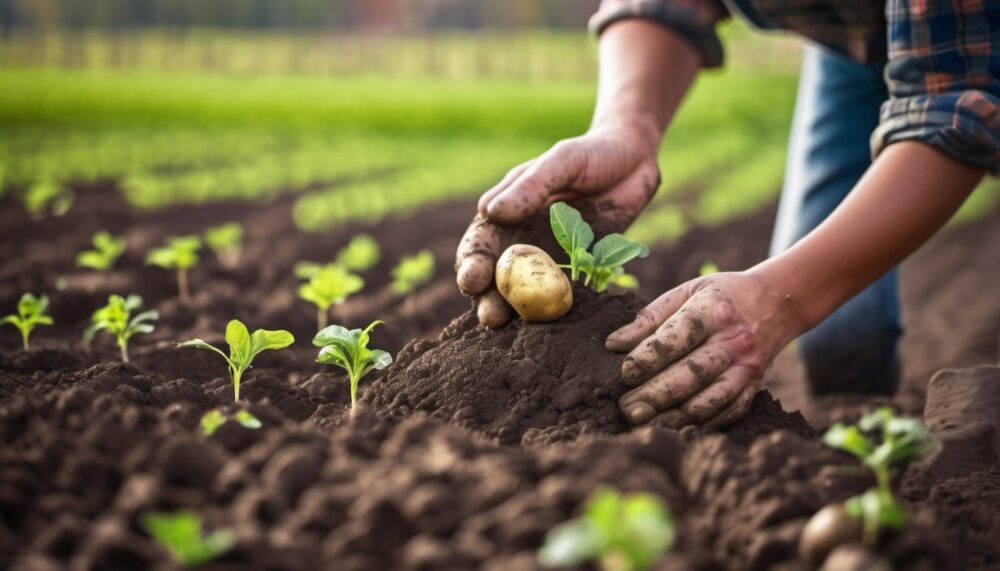
Based on calories per unit area:
- Oil palm: Takes the crown for most calories per acre, thanks to its high oil yield. However, it requires specific tropical climates and intensive cultivation, making it impractical for most individual growers.
- Sweet potatoes: Offer the highest caloric yield per hectare in a wider range of climates, making them a good choice for home gardens and sustainable food production.
- Cassava: Another contender, particularly in warm, humid regions, with high calorie yield per area.
For individual gardens:
- Potatoes: Easy to grow and provide a high number of calories per square foot planted. Just be aware of potential potassium excess from relying solely on potatoes.
- Jerusalem artichokes: Produce substantial underground tubers rich in starch and calories. They are also resilient and tolerant of various soils and climates.
- Legumes (beans, lentils): While not top contenders in calorie density, their high protein content offers additional nutritional value and can contribute significantly to daily calorie intake.
Bonus options:
- Fruit trees: Banana, breadfruit, and jackfruit can offer high calorie yields over longer periods compared to annual crops.
- Grain crops: Corn and wheat are major calorie sources globally, though require larger spaces and specific conditions for optimal yields.
Remember, “most calories” doesn’t necessarily mean the best choice. Consider factors like climate, available space, nutritional balance, and personal preferences when selecting plants for your calorie needs.
For a more specific recommendation, tell me more about your situation:
- Where do you live?
- How much space do you have available?
- What are your experience levels with gardening?
- Do you have any dietary restrictions or preferences?
Growing a bountiful harvest of potatoes at home requires some strategic planning and consistent care. Here are some tips to maximize your potato yield:
Choosing the right method:
- Raised beds: Ideal for areas with poor drainage or limited space. Fill a frame with a blend of soil, compost, and manure, allowing you to control the soil quality and easily mound as the potatoes grow.
- Hilled rows: Dig trenches, plant seed potatoes, and gradually mound soil around the stems as they grow, encouraging tuber formation.
- Containers: Perfect for balconies or patios. Use large pots (at least 15 gallons) with drainage holes and well-draining potting mix.
Preparing the potatoes:
- Seed potatoes: Invest in certified disease-free seed potatoes, not grocery store potatoes, as they’re specially chosen for growth.
- Sprouts: “Chit” your potatoes by placing them in a cool, bright location for a few weeks before planting. This encourages sprouts to develop, leading to faster and stronger growth.
- Cutting (optional): You can cut larger seed potatoes into pieces with at least one “eye” each. Ensure cuts are dry and healed before planting.
Planting and care:
- Soil pH: Aim for slightly acidic soil with a pH between 6 and 6.5. Amend soil with compost or manure if needed.
- Sunlight: Choose a sunny location with at least 6-8 hours of direct sunlight per day.
- Spacing: Plant seed potatoes 12-18 inches apart and cover with 2-3 inches of soil.
- Watering: Keep the soil consistently moist, but not soggy. Aim for 1 inch of water per week.
- Fertilizing: Side-dress with a balanced fertilizer 4-6 weeks after planting and again two weeks later.
- Hilling: As the plants grow, mound soil around the stems to encourage tuber development. Repeat every few weeks until the base of the plant is buried 8-12 inches deep.
- Pests and diseases: Monitor for Colorado potato beetles and blight. Remove beetles by hand or use organic insecticidal soap. Be proactive with blight prevention by choosing resistant varieties and rotating planting locations.
Harvesting and storage:
- Harvest potatoes when the foliage dies back or turns yellow. Gently dig around the plants to avoid damaging tubers.
- Cure potatoes in a cool, dark, well-ventilated space for 1-2 weeks to allow skins to set and prevent rotting.
- Store cured potatoes in a cool, dark place with high humidity, like a root cellar or basement.
Bonus tips:
- Choose potato varieties well-suited to your climate and preferences.
- Interplant with companion plants like marigolds and herbs to deter pests.
- Mulch around plants to retain moisture and suppress weeds.
- Keep a garden journal to track your planting dates, care practices, and harvest results. This will help you refine your strategy for future seasons.
With dedication and these tips, you can enjoy a delicious and abundant harvest of homegrown potatoes!
